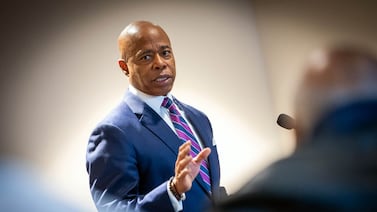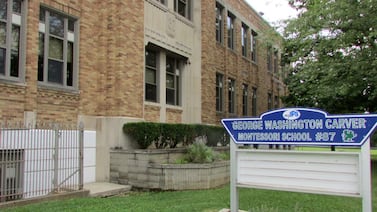This story originally appeared in Colorado Community Media. It is republished here with permission.
Max Malone and his family moved from Denver to Castle Rock after his family weathered financial struggles, hoping the town could provide a less stressful environment for his younger siblings.
Instead Malone — whose father is Black and mother white — said he encountered significantly more racism than he did when living in other Denver metro area communities.
During his sophomore and junior years at Castle View High School, Malone — a student of color in a school that was nearly 80% white — grew increasingly demoralized as he said he repeatedly found bathroom stalls vandalized with racist slurs. One of the messages, he said, read: “Kill (N-word)!”
After the first couple instances, Malone took photos and returned to class, disturbed and unable to concentrate. When the vandalism continued, he alerted office staff, he said. Eventually, Malone said several students of color went to the office and pleaded with Castle View staff to do something about it.
“They were all kind about it and stuff,” he said, “and they didn’t really do anything about it.”
The district, through its spokeswoman, did not directly address Malone’s allegations. The district did not make Castle View Principal Rex Corr available for interviews, nor did Corr respond to questions submitted for him via the spokeswoman regarding the alleged racist graffiti.
In several statements to Colorado Community Media, the district said it is “committed to providing a safe learning and work environment where all members of the school community are treated with dignity and respect.”
A 2020 graduate, Malone, 18, still has the photos on his phone.
“Just one after another after another,” he said. “After a while, I just stopped taking pictures of them.”
‘Make noise’
Douglas County Schools is a predominantly white school district in a county where 89% of residents identify as white alone, according to the U.S. Census. A little more than two-thirds of the district’s roughly 63,000 students identified as white this school year, with Latinos making up the largest group of students of color. Only 1% identify as Black or African American, according to district data.
African Americans are equally underrepresented among staff: The district had one Black principal or assistant principal at the helm of its roughly 90 schools last semester, according to data provided by the district through a records request. The district employed more than 60 teachers who identify as Black or African American as of Dec. 1, according to the district’s data, about 1% of its teaching force.
Amid a national reckoning on racism in 2020, current and former Black students joined Black Lives Matter protests throughout Douglas County communities. Some took a knee as the national anthem played during in-person high school graduations.
In the aftermath of protests, four students, current and former, called on district leaders to foster more respect among peers, and in interviews with Colorado Community Media, the students said they want greater systemic support — from clubs for students of color to assemblies that address negative treatment of students of color when it arises.
The district should also revisit how Black history — which the students emphasize is American history — is taught in classrooms, they said. At least one piece of curriculum, from the literacy company Fountas and Pinnell, has been criticized for perpetuating racist stereotypes about African Americans and people of color, former Chief Academic Officer Marlena Gross-Taylor told Colorado Community Media shortly after she left the district last year.
Ken Scales, whose daughter was among the students who spoke to us, said his two daughters each experienced inappropriate behavior from peers and school staff during teacher-led class discussions and through culturally insensitive assignments.
“I found myself a couple of times wanting to put on my suit of armor and charge into the school,” he said.
School district leaders declined repeated requests by Colorado Community Media to talk about the experiences of its Black students, but the district has included improving its culture as part of its strategic plan. In its statements to Colorado Community Media, the district further said it is evaluating how its curriculum addresses Black history and other multicultural histories.
The district’s Equity Advisory Council also has been drafting the district’s first-ever equity policy, which includes a commitment to root out systemic racism and racial inequities.
During their Feb. 16 meeting, school board directors took turns reading the policy aloud, but did not ask questions or discuss the document beyond thanking the equity team for drafting it. Director Susan Meek urged the community to review the policy and weigh in.
Former Superintendent Thomas Tucker told Colorado Community Media in February an equity policy “is an excellent start” for school districts, but said they should also be adopting stand-alone policies that exclusively focus on racial equity.
“Your district has to be bold enough to admit that you are going to have to focus on anti-racism and social justice and you have to recognize that African-American and other students of color face biases,” he said.
Tucker, who left the district in 2020, raised concerns about racism — overt and subtle — in the district as well. In addition to what he saw as his own experiences with discrimination as the district’s first Black superintendent, he recalled having to address high school students waving a Confederate flag during football games.
It’s not only students of color who benefit from a racially equitable system, he said.
“This impacts the lives of white students just as much, and one could also argue more so, because at some point in time they will leave the Douglas County School District, the Douglas County bubble,” he said. “When we don’t address this in school, we are robbing kids of a skill set.”
But Tucker said it is up to the entire community, not only the board or district administrators, to say “enough is enough” when it comes to racism in schools. And Gross-Taylor, who voiced her own concerns about the lack of diversity in the system, had a message for students:
Protest. Speak up at school board meetings. Don’t stop with the school principal. District administration can’t fix problems they do not know about, she said.
“What I would say to those kids is ‘make noise.’”
The four current and former students who spoke to Colorado Community Media do not claim to speak for the experiences of all the district’s Black or mixed-race students, but their stories share commonalities that point to the work the district has ahead — stories Tucker said that “as a parent, as an African American, it breaks my heart.”
Kennedi Scales, 17, Douglas County High School
Kennedi Scales can’t forget the time a Douglas County School District teacher put her on the spot during a class discussion of “To Kill a Mockingbird.”
“In front of the whole class, (my teacher) asked me how I would pronounce the word, ‘Ask,’” she said.
Kennedi recalled pausing for a moment, realizing her teacher associated African Americans with improper speech, she said.
Instantly, she felt “marginalized and underestimated.”
Repeating the word, Kennedi said she pronounced it as clearly as she could.
“To show I’m Black, and I’m educated,” she said.
Kennedi said embarrassment kept her from telling administrators about the situation, which was several years ago, but, she said, she also feared the school would not take action.
The 17-year-old, now a senior, said she experiences subtle or unintentional discrimination weekly.
She said she often feels expected to act as a spokesperson for all Black people, including by teachers, who have asked her to share her perspective because she was the only African American student in her class.
Kennedi’s father, Ken, said that expectation has created uncomfortable environments for both of his daughters, including Kennedi’s 15-year-old sister Trinity, who faced her own set of racially insensitive scenarios before leaving the district to pursue music education in Denver.
Trinity once came home with an assignment asking students to write about the American Dream and how it attracted their families to the U.S., he said. As a student of both African-American and American Indian heritage, Trinity did not know how to approach the task.
Ken Scales emailed the teacher. His daughter could write about the Trail of Tears, her ancestors arriving in the U.S. on slave ships, or people in her family who were lynched, he said, but asking her to reflect on the American Dream did not consider her perspective.
“I don’t think (the teacher) really thought that out,” he said.
Ken Scales said he and his wife have taught their daughters to self-advocate and speak up if they feel uncomfortable in the classroom. They know their mother and father will step in if they need.
Usually the girls do address their concerns. Though on occasion, Kennedi has preferred to avoid stirring the pot if she worried it might jeopardize her grades, Ken Scales said.
Kennedi is a student in the International Baccalaureate program and among the top in her class, he said.
She is also a violinist, chamber orchestra member, National Honor Society member, and Future Business Leaders of America member.
She stays busy. That doesn’t mean she is too busy for more activities, she said. Kennedi wants to see a club like the Black Student Alliance added at Douglas County High School. The national organization aims to provide Black students and allies with community in their school buildings.
Without more inclusivity built into schools, students of color turn to each other for community, she said.
“I guess we’re drawn to each other because of that, and there’s not really a support system in the schools,” she said.
Tommy Crawford, 2020 ThunderRidge High School graduate
Tommy Crawford, who is both African American and white, said he faced numerous stereotypes at ThunderRidge High School.
He watched people move phones off their desks when he walked in a room. Others hid their keys.
“They might be doing it on accident, but I do see it. And it’s the little things like that,” he said.
White peers’ use of the N-word in Douglas County schools also arises amid a lack of cultural awareness and education, said Crawford, 18.
“White kids, they think it’s normal to say the N-word in their normal vocabulary because they have no people to say it’s not OK,” Crawford said. “That’s a big problem.”
Black students have to adapt to living in a predominantly white area, he said, explaining “you start talking a little bit more white, if that makes sense, with a little less slang.”
One of Crawford’s Black friends who transferred to ThunderRidge stopped using the N-word after white peers began saying it, Crawford said.
Racism and subtle discriminatory acts wear students of color down mentally, he said, adding “it’s pretty much everywhere in schools.”
“It’s most definitely in school classrooms,” Crawford said. “That’s where most of the white-to-Black contact is.”
Crawford said he often felt like an outcast. A discussion on slavery during history class could prompt classmates to turn and look at him, “like, this is your topic,” he said.
“I am primarily the only Black kid in most classes. Pretty much all my classes, and it just makes me feel different from everyone else,” Crawford said the summer after his graduation.
An athlete, Crawford earned awards like “Most Improved Player” and “Hardest Worker” during his high school basketball career, he made honor roll and also enjoyed sewing. For a senior project, he made his own pair of boots.
Crawford said he wished his high school were more diverse. He longed for a larger Black and African-American population to feel more included, more comfortable, and so that new students of color could more easily transition to a different place.
Crawford left ThunderRidge as a varsity basketball player and now plays forward for Colorado College in Colorado Springs.
Anya Jackson, 2020 Castle View High School graduate
Unlike Malone, Crawford and Scales, Anya Jackson, who is African American, said she never experienced overt racism during her time at Castle View. Clubs were welcoming, and teachers and staff were supportive, she said. She could not remember people “making me feel less safe because I am a person of color.”
What she did feel, she said, was a pressure to set realistic expectations of Black or African American people in an area with little diversity.
“Just because there’s not that many of us. I feel like people would get an idea of how we act, how we dress, our mannerisms,” she said, and then go on to associate those perceptions with all African Americans.
Jackson, 18, echoed the concerns about a lack of inclusive curricula. She recalled a small section on Black history in a humanities class she took her sophomore year but remembered little other focus on Black history in her education.
She does not remember her school celebrating Black History Month.
“I felt like there are also a lot of books and historical stories that could be incorporated into classes that just aren’t,” she said.
Jackson did not think her teachers intentionally overlooked Black history in classes, and instead suspects it’s more of a blind spot in the system.
“I feel like it’s just not one of those things that teachers and staff realize they don’t do,” she said. “Just because there is not much diversity.”
Max Malone, 2020 Castle View High School graduate
Malone described a tumultuous personal journey learning how to handle racism at school. He went through rough patches after moving to town, he said, including occasionally getting into trouble for behavioral issues.
His senior year, police officers came to Castle View with a warrant for his arrest on allegations of assault, he said.
“I did do a few stupid things.”
But, he said, some of his acting out was triggered by racist incidents. School staff sought to discipline Malone after he kicked a vandalized stall in the bathroom, breaking the door so that everyone who walked in could see the slur.
Malone said he did not deny breaking the stall but was disappointed when school staff appeared more concerned with his reaction than the racist language.
Malone suspects many of his teachers did not expect he would graduate amid struggling academics and behavioral incidents. He worked double time his senior year to bring up his grades, he said.
Principal Rex Corr, who Malone said once tapped him in gym class, gently telling him police had come to arrest him, eventually watched Malone walk across a graduation stage.
“When he handed me my diploma, he started tearing up and crying and said, ‘I’m proud of you,’” Malone said, adding that he had nothing but respect for Corr.
Malone now works in Castle Rock and has dedicated a corner of his home to music production.
Songs fill his computer, including one he wrote last year about racism called “No Folding Me.”
People are talking too openly
And racially
So I’m hoping that my poetry
Can bitter down that bigotry
And open up the imagery
So we can see the dignity
And symmetry in humanity







